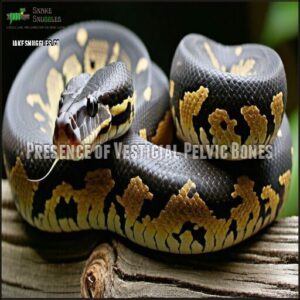This site is supported by our readers. We may earn a commission, at no cost to you, if you purchase through links.
 Do snakes have hips? Not quite, but the story’s not that simple.
Do snakes have hips? Not quite, but the story’s not that simple.
While snakes don’t have functional hips like you do, some species have tiny, leftover bones called pelvic spurs near where hips would’ve been.
These are vestigial, meaning they’re leftover from their legged ancestors. Think of them as evolutionary "souvenirs" from when snakes used to have legs millions of years ago.
Today, these bones don’t help with movement, though some snakes, like pythons, use them during mating. It’s a fascinating glimpse into their evolutionary past and what nature decided they no longer needed.
Curious about more snake facts? Stay tuned!
Table Of Contents
- Key Takeaways
- Anatomy of a Snake’s Skeleton
- Snakes and Hips: a Common Misconception
- Evolutionary Significance of Snakes’ Hips
- Snakes’ Unique Skeletal System
- Body Parts Snakes Do Not Have
- Frequently Asked Questions (FAQs)
- Do snakes have pelvic bones?
- Did ancient snakes have hip bones?
- Did snakes have legs in the past?
- Do snakes have limbs?
- Which snakes had hind limbs in the past?
- Do snakes need pelvis?
- What is the Average Lifespan of a Snake?
- What Adaptations Do Snakes Have to Help Them Survive in the Wild?
- Are Snake Hips Different From the Hips of Other Animals?
- Is There a Way to Tell the Age of a Snake Just by Looking at It?
- Conclusion
Key Takeaways
- Some snakes, like pythons and boas, have tiny, leftover pelvic bones called vestigial structures from their legged ancestors.
- These small pelvic bones don’t help with movement but play roles in mating and reproduction, like anchoring muscles or aiding with reproduction.
- Fossil evidence, like the ancient snake Najash, shows that snakes evolved from reptiles with functional legs and hips millions of years ago.
- Vestigial pelvic bones in snakes highlight their evolutionary history, similar to traits like whale leg bones or flightless bird wings.
Anatomy of a Snake’s Skeleton
A snake’s skeleton is a fascinating design of hundreds of vertebrae and ribs that give its body flexibility and strength.
While most snakes lack hips, some species retain tiny vestigial pelvic bones as a reminder of their legged ancestors, and this feature is a notable aspect of their skeleton.
Presence of Vestigial Pelvic Bones
Hidden beneath a snake’s sleek appearance lies a fascinating evolutionary story: vestigial pelvic bones, small remnants of their legged ancestors. Although snakes slither and lack visible limbs, some still retain these tiny structures near their tails.
Tiny pelvic bones in snakes tell an ancient tale of evolution, linking modern slitherers to their legged reptilian ancestors.
You can buy snake pelvic bone products online. Boas and pythons, considered primitive species, display more noticeable pelvic spurs.
These vestigial hips in snakes reveal their fascinating transformation from legged reptiles to streamlined slitherers.
Here’s what makes these structures remarkable:
- Tiny, spine-disconnected remnants near the cloaca.
- Evidence of functional legs in their ancestors.
- More pronounced in species like boas and pythons.
- Embedded in muscles near the tail.
- Provide insight into snake pelvic girdle evolution.
Functionality of Pelvic Bones in Snakes
The vestigial pelvic bones in snakes aren’t just useless remnants from their legged ancestors—they’ve taken on new roles that help these fascinating reptiles.
Though snakes no longer walk or rely on these bones for movement, their functionality reveals how evolution repurposes anatomical features.
For example, these bones act as muscle anchors, supporting slithering by anchoring key muscles.
In mating assistance, male snakes use pelvic spurs (tiny remnants of legs) to grip females during courtship.
Additionally, the snake pelvic girdle offers internal stability, keeping organs secure during movement and tight squeezes.
In some cases, these vestigial hips in snakes even support minor roles like providing environmental grip on narrow surfaces or aiding climbing movements in certain species.
These seemingly small support structures showcase nature’s ability to adapt, capturing the remarkable blend of functionality and evolutionary history behind snake hips.
Comparison With Other Animals’ Skeletal Systems
Snake skeletons are fascinating examples of skeletal adaptations. Unlike lizards with sturdy hips and limbs, snakes rely on their long spines for streamlined slithering.
Their vertebral differences—hundreds of flexible ribs and no functional hips—make precise, agile movement possible. Some enthusiasts explore the snake skeletal system for deeper understanding.
Some snakes retain vestigial pelvic bones or pelvic spurs, remnants of ancient limbs. By comparison, birds use lightweight bones for flight, while amphibians depend on four limbs to navigate land and water.
This comparative anatomy underscores the unique beauty of snake evolution and limb loss.
Snakes and Hips: a Common Misconception
You might think snakes don’t have hips, but that’s not entirely true.
Some snakes, like pythons and boas, still carry tiny, hidden bones near their tails that are leftover from their legged ancestors.
Vestigial Features in Snakes
Did you know some snakes have tiny, hidden “hips”? These vestigial pelvic bones are throwbacks to their legged ancestors.
In species like pythons and boas, they exist as leg remnants, often alongside pelvic spurs—small projections near their tails. These vestigial features aren’t just historical artifacts; spurs help during mating or climbing.
- Pelvic spurs assist with gripping during reproduction.
- Hip bones hint at an ancient evolutionary path.
- Faint traces of leg bones remain visible in some species.
- Primitive snakes may even retain remnants of a shoulder girdle.
Evolutionary History of Snakes
Long before their legless slither, snakes were creatures of the land with legs. Fossil evidence, like the remarkable Najash discovery in Argentina, shows ancient snakes with hips and small legs—clear links to their legged ancestors.
Ancient snakes, like Najash, walked on land with legs and hips, offering a glimpse into their incredible evolutionary journey.
These snakes roamed about 90 million years ago, using their legs for tasks like digging or crawling. Snakes and lizards exhibit remarkable examples of convergent evolution, adapting similar traits for similar lifestyles.
As evolution progressed, snakes exchanged limbs for flexibility, paving the way for their sleek, elongated bodies. This limb loss, driven by adaptive radiation, helped snakes master slithering and survive in diverse habitats.
Here’s a quick look at their evolutionary journey:
| Evidence | Time Period | Features | Importance | Habitat |
|---|---|---|---|---|
| Legged Ancestors | 100+ million yrs | Fully formed legs | Terrestrial mobility | Land-based |
| Najash fossils | ~90 million yrs | Hips, small legs | Intermediate traits |
Comparison With Other Animals’ Vestigial Features
Snakes aren’t the only creatures with evolutionary leftovers.
When you look at whale leg bones hidden beneath blubber or an ostrich’s wings that can’t fly, you’re seeing the same story of adaptation.
Vestigial features appear across species—human appendixes, cave fish eyes that no longer see, and flightless bird wings all testify to evolutionary history.
These vestigial structures, like snakes’ tiny pelvic bones, aren’t useless mistakes—they’re biological bookmarks showing how species adapted to changing environments over millions of years, demonstrating vestigial features and the power of evolutionary leftovers.
Evolutionary Significance of Snakes’ Hips
You’ll find tiny hip bones in some snakes like pythons and boas that tell us they evolved from four-legged reptiles.
These vestigial structures serve as physical proof of evolution, showing how snakes traded their legs for the streamlined, flexible bodies you see today, which is a clear example of vestigial structures.
Insights Into Snake Evolution
Ever wonder how snakes slithered their way into evolution?
Fossil evidence, such as Najash, sheds light on this transformation.
These ancient snake fossils reveal legged ancestors with vestigial pelvic bones and small legs.
Snakes and lizards demonstrate convergent evolutionary adaptations.
Over time, adaptive radiation led to limb loss, prioritizing flexibility for streamlined movement.
This evolutionary milestone shows how early snakes traded legs for mobility advantages, emphasizing their shift into highly specialized reptiles.
Snake hips, like pelvic spurs, now serve minimum roles but highlight a fascinating lineage.
The Najash significance offers a window into snake evolution, showing how these creatures walked the Earth before perfecting their slithering expertise.
Each vestige tells a story of adaptive innovation.
Implications for Understanding Vestigial Features
Snake hips, like tiny fossils within living creatures, reveal incredible insights into evolutionary history. These vestigial pelvic bones, especially in boas and pythons, link modern snakes to legged reptiles.
They may be small but aren’t entirely useless. Over time, these vestigial structures found new roles, such as anchoring muscles for movement and aiding reproduction.
Such remnants highlight how adaptive radiation reshapes designs, keeping what works and repurposing the rest. It’s like nature’s way of recycling. Scientists use genetic evidence to dig deeper into these changes, helping us track evolution’s winding road.
Here’s why snake hips matter:
- Showcases adaptive radiation.
- Connects snakes to legged ancestors.
- Represents how vestigial features evolve new functions.
- Offers clues for future research into reptile anatomy.
Comparison With Other Animals’ Evolutionary Histories
Nature’s blueprint shows fascinating parallels between snake evolution and other animals.
Limb loss and vestigial pelvic bones tell the story of adaptation:
- Whales illustrate limb loss with vestigial pelvic bones from their legged ancestors.
- Ostrich wings serve no flight purpose, much like snake hips lack locomotion function.
- Cavefish embody adaptation with vestigial eyes in darkness.
- The human appendix, often debated, reflects evolutionary inheritance.
These examples highlight how evolutionary designs evolve yet remain strikingly interconnected, demonstrating vestigial traits and adaptation in various species.
Snakes’ Unique Skeletal System
You might be surprised to learn how complex and specialized a snake’s skeleton is.
With hundreds of vertebrae, modified ribs, and unique skull features, their bodies are built for incredible flexibility and strength.
Highly Flexible Backbone
You might be amazed by the spinal flexibility of a snake.
With up to 600 vertebrae, their backbone is built for agility.
This unique vertebral structure lets them twist, coil, or glide with stunning precision.
Unlike animals with stiff skeletons, snakes rely on muscular control and movement mechanics to navigate tight spots or climb with ease.
Their vertebrae are designed for fluid, adaptive motion, giving them unmatched advantages in their environment.
The snake spine structure proves nature’s genius, supporting incredible vertebral adaptations that make these creatures masters of movement—no hips required!
Modified Ribcage and Skull
A snake’s skeleton cleverly adapts for slithering and swallowing massive prey.
Its ribcage flexibility and skull adaptations are remarkable:
- Free-floating ribs expand, aiding digestion of large meals.
- Vertebral adaptations boost agility for smooth movements.
- Lightweight skull characteristics allow easier, faster head motions.
- Unique sensory openings enhance perception while maintaining strength.
This modified ribcage and flexible skull make snakes masters of stealth, speed, and efficient feeding mechanics in the animal kingdom.
Specialized Jaws and Fangs
A snake’s jaws are an engineering marvel, built for venom delivery and prey capture.
Their jaw mobility is astounding—flexible connections let the jaws stretch wide enough to engulf prey much larger than their heads.
Snake fangs vary by species, optimized for injecting venom with precision.
Equipped with strong bite force, their teeth are sharp, curved backward, and designed to grip prey securely.
These teeth, including fangs, undergo constant tooth replacement to stay sharp.
Everything about a snake’s jaws, from sensory organs to structure, guarantees efficient feeding and survival.
Examples of Vestigial Organs
Hidden within a snake’s body are vestigial structures, like tiny pelvic bones and pelvic spurs. These leftovers from their legged ancestors reveal an evolutionary story, much like whale leg bones or flightless bird wings.
Snakes’ flexible skeletal structure allows for unique movement and hunting adaptations.
- *Did you know?
- These hip bones, though non-functional for walking, help some snakes during mating.
Fossils show snakes evolved from reptiles with hips and legs, trading limbs for flexibility. Similar to the human appendix or wisdom teeth, these vestigial organs, such as spurs, highlight adaptive changes while connecting snakes to their ancient, lizard-like relatives.
Body Parts Snakes Do Not Have
You might be surprised to learn that snakes are missing some features you’d expect in most animals, like external limbs and fully developed hips.
Over millions of years, their bodies have adapted by losing these structures, making them perfect for slithering through their environments.
Absence of External Limbs
You might think legs are essential for mobility, but snakes prove otherwise.
Through limb loss, their evolution showcases remarkable environmental adaptation and survival. Without external limbs, snakes rely on their flexible spine and unique body plan benefits to thrive across various terrains. Their slithering mechanics make them surprisingly versatile.
Here are five ways leglessness evolution works in their favor:
- Wriggle through tight spaces—their body can squeeze where others can’t.
- Glide through water, resembling torpedoes in motion.
- Climb effectively, gripping surfaces like pros.
- Stealthy movement, stalking prey unnoticed.
- Support from vestigial pelvic bones, including hip structure remnants like pelvic spurs.
Snake hips? Adaptation in action!
Reduced or Modified Skeletal Structures
Imagine this scenario: a skeleton designed for flexibility and efficiency.
Snakes’ spinal adaptations include up to 400 vertebrae, allowing their smooth, slithering motion. Surrounding this flexible spine is a protective ribcage that supports their ability to swallow prey whole.
Forget functional hips—what remains are vestigial pelvic bones and pelvic spurs, tiny reminders of their legged ancestors. These limb remnants no longer serve movement but speak volumes about evolution’s handiwork.
With their slender, cylinder-like frame, every piece of their anatomy—ribs, spine, even their streamlined hip structure—is fine-tuned for survival. Their vestigial structures highlight adaptation’s role in perfecting mobility.
Adaptations for Slithering and Flexibility
In terms of seamless movement, snakes are pros. Their streamlined body and unique features turn them into slithering marvels.
Scientists have studied snake limb development genes to understand their evolutionary history. Let’s break it down:
- Their flexible spine, made of hundreds of vertebrae, lets them twist and turn with precision.
- Muscle adaptations create those famous wave-like motions for smooth travel.
- A robust ribcage structure expands and contracts, adding agility and coordination.
- Specialized skin flexibility and strong belly scales grip surfaces, boosting traction.
These impressive traits make snakes’ locomotion both efficient and hauntingly graceful.
Frequently Asked Questions (FAQs)
Do snakes have pelvic bones?
Snakes have tiny pelvic bones, remnants of their legged ancestors.
These rice-sized structures, near the base of their tails, don’t help with movement but anchor muscles for mating and slithering, especially in species like pythons and boas.
Did ancient snakes have hip bones?
Ancient snakes had hip bones, and some even had small, functional legs.
Fossil evidence, like the Najash rionegrina discovery, reveals these structures were likely used for crawling, digging, or locomotion before evolving into vestigial forms.
Did snakes have legs in the past?
Yes, snakes had legs millions of years ago.
Their limbed ancestors used them for walking or digging.
Over time, evolution favored slithering, leading to leg loss, though some species still have tiny, vestigial pelvic bones.
Do snakes have limbs?
Some snakes, like boas and pythons, have tiny, vestigial limbs called pelvic spurs near their tails.
These remnants of ancestral legs aren’t used for walking but assist during mating.
Most snakes, however, lack visible limbs, which is a key characteristic that distinguishes them, with vestigial features being remnants of their evolutionary past.
Which snakes had hind limbs in the past?
When you dig into history, some ancient snakes, like Najash rionegrina, had hind limbs.
These vestigial legs were functional for crawling or digging, showcasing their evolution from legged reptile ancestors over millions of years.
Do snakes need pelvis?
They don’t really need a pelvis for moving around, but it helps anchor muscles used for slithering and mating.
In some species, small pelvic remnants even support reproductive functions or combat during mating rituals.
What is the Average Lifespan of a Snake?
Imagine a snake curling around for decades—some species live 10-20 years in the wild, while captive snakes can reach 30 due to controlled environments, steady food, and less danger.
It’s all about good care!
What Adaptations Do Snakes Have to Help Them Survive in the Wild?
With stretchy jaws, camouflage, and heat-sensing pits, they’re survival pros.
Some mimic venomous species while others strike fast or squeeze prey tightly.
Add a flexible spine and silent movement, and you’ve got nature’s stealthiest predator with abilities that make them highly effective hunters, utilizing their heat-sensing pits to locate prey.
Are Snake Hips Different From the Hips of Other Animals?
Snake hips, unlike those in most animals, are tiny, vestigial bones near their tails.
They don’t support movement but anchor muscles for mating or slithering.
Boas and pythons even have visible spurs, remnants of ancestral legs.
Is There a Way to Tell the Age of a Snake Just by Looking at It?
You can’t tell a snake’s age just by looking.
Unlike trees with growth rings, snakes don’t show visible aging signs.
Size can suggest age, but factors like diet, species, and environment make it unreliable.
Conclusion
Snakes and hips might sound like the start of a bad joke, but it’s all about evolution.
While snakes don’t have functional hips, some, like pythons, keep those tiny pelvic spurs—leftovers from their legged ancestors.
These vestigial bones don’t help them move but play a role in mating.
It’s a wild reminder of nature’s ability to adapt and streamline.
So, do snakes have hips? Not really, but they’ve got the evolutionary receipts to prove their past.















